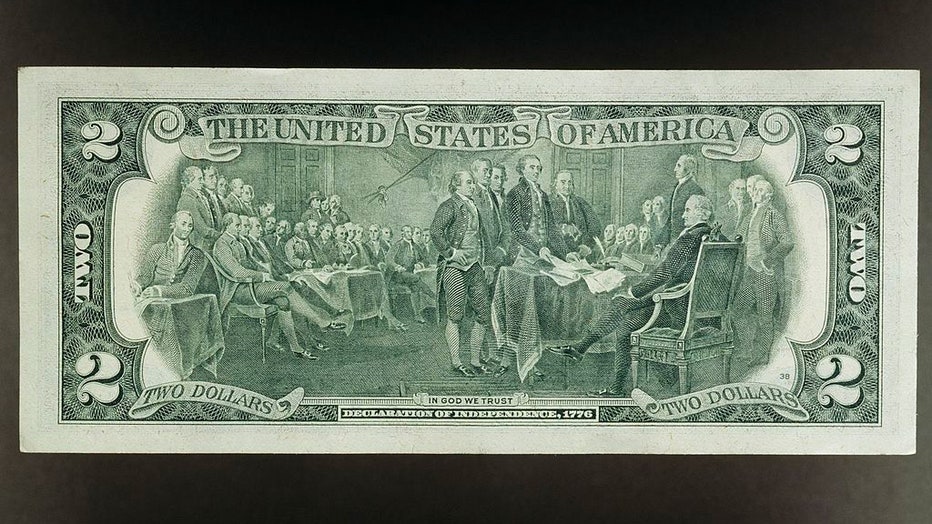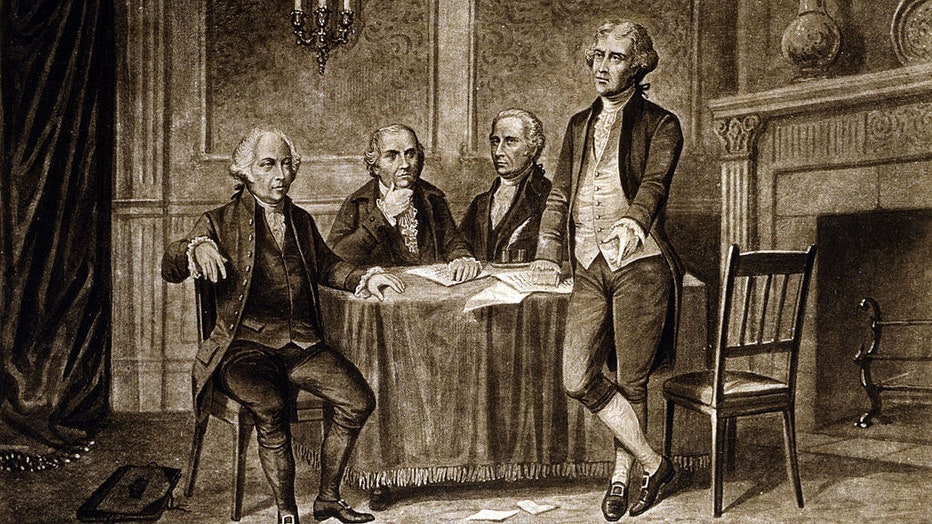$2 bills from 1890 could be worth over $4,500: report
FILE-The United States two-dollar bill ($2) is a current denomination of U.S. currency. A portrait of Thomas Jefferson, the third President of the United States (1801–09), is featured on the obverse of the note. (Peter Dazeley via Getty Images)
Historically, $2 bills have been thought to be a sign of "bad luck."
Americans might change their minds about that after learning how much these rare bills can be worth.
An estimated price list published by U.S. Currency Auctions, a website dedicated to documenting paper money resources for collectors, suggests that some $2 bills can be worth hundreds or even thousands of dollars.
Two-dollar bills that have been in circulation have a variable average value that’s between $2 and $2,500, depending on the year those bills were released, according to U.S. Currency Auctions.
RARE DOUBLED DIE ERROR PENNIES SELL FOR BIG BUCKS. HERE'S WHAT THEY ARE, AND HOW TO FIND ONE
Uncirculated $2 bills, on the other hand, have a variable average value that’s between $2 and $4,500 — which also depends on the release year and other physical factors.
Older $2 bills generally command a higher value, but a bill's note type and seal color also play a factor in each bill’s worth, according to U.S. Currency Auctions.
Bill types that U.S. Currency Auctions have estimated values for at the time of publication include the United States Note, the silver certificate, the treasury note, the National Bank Note (National Currency/FRBN) and the Federal Reserve Note.

FILE-$2 dollar banknote, obverse, Thomas Jefferson (1743-1826). United States of America, 20th century. (Photo by DeAgostini/Getty Images)
The paper money auction resource also organized $2 bill values by seal color, which can be red, brown and red, brown and blue, red and blue, brown, blue or green.
THIS IS THE RAREST, MOST VALUABLE US BILLS COLLECTION ON THE PLANET
There are two uncirculated $2 bills that have a value that can exceed $4,500, according to U.S. Currency Auctions.
Both are treasury notes from 1890. One has a brown seal, while the other has a red seal.
Many $2 bills listed on eBay — a popular multinational auction website — are packaged in sets that are priced from as low as $7.50 to as high as $10,000.
Current listings for $2 bills on GreatCollections Coin Auctions have bids that don’t exceed $100.
GreatCollections Coin Auctions is the official auctioneer of the American Numismatic Association, a nonprofit organization that educates the public about coins, currency, medals, tokens and related objects.
RARE COIN SELLS FOR $4.2 MILLION

FILE-$2 dollar banknote, reverse, Declaration of Independence. United States of America, 20th century. (Photo by DeAgostini/Getty Images)
FOX Business recently reported that coin collectors put a high value on "doubled die" coins, a type of rare coin that isn’t supposed to go into circulation when there is a detectable double stamping, but accidentally gets released to the public.
Blake Alma, of Lebanon, Ohio, a coin collector and founder of the coin-collecting blog CoinHub, told FOX Business that the rarity of a piece of currency usually adds "an extra level of excitement and interest" for collectors.
"Many people are willing to pay top dollar for unique and rare pieces to add to their collections," he said.
In 2021, the Federal Reserve System Board of Governors reported that about $2.8 billion worth of $2 bills were in circulation.
Two-dollar bills were once viewed as a negative piece of currency; that's because these bills were often used for bribery, election rigging, gambling and prostitution during the 1920s, according to a report published by CNB St. Louis Bank.
Superstitious believers eventually deemed the bill denomination to carry bad luck.
"The $2 bill was often thought to be bad luck, as ‘deuce’ was a name for the devil," CNB St. Louis Bank wrote.

FILE-Leaders of the Continental Congress 1775 : John Adams, Robert Morris, Alexander Hamilton, Thomas Jefferson, drawing by Augustus Tholey (1894). (Photo by APIC/Getty Images)
"Recipients would tear off one corner, believing it would negate the bad luck of the bill. This caused many of the bills to be taken out of circulation as mutilated currency."
The $2 bill debuted in 1862. It first featured a portrait of founding father Alexander Hamilton, the first secretary of the Treasury, according to the U.S. Bureau of Engraving and Printing.
Hamilton’s portrait was replaced by that of Thomas Jefferson, the third U.S. president, with the Series 1869 United States Notes.
He remains the face of the $2.
The Bureau of Engraving and Printing says there are no plans to redesign the $2 note.
Get the latest updates on this story at FOXBusiness.com.

